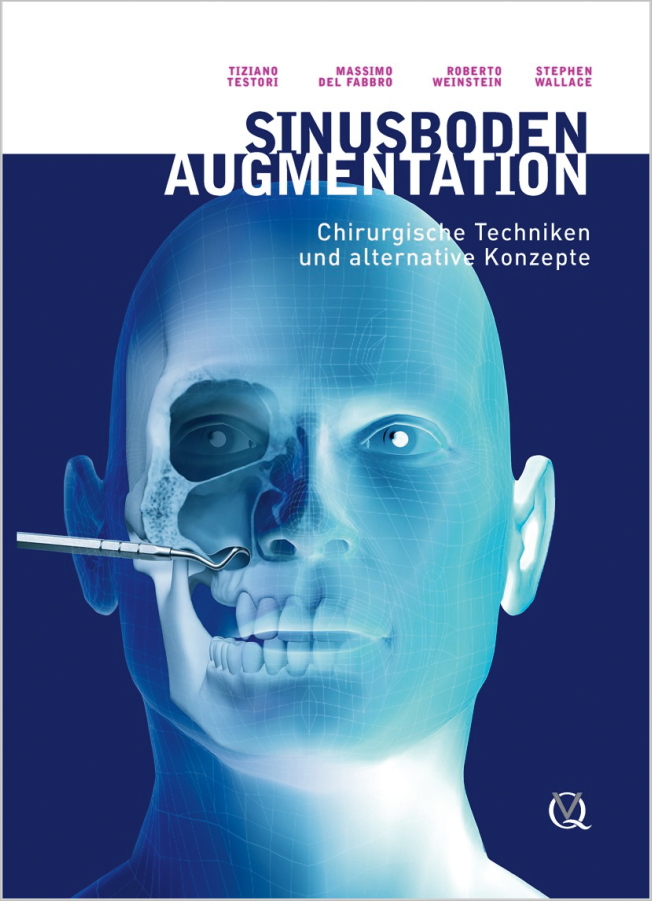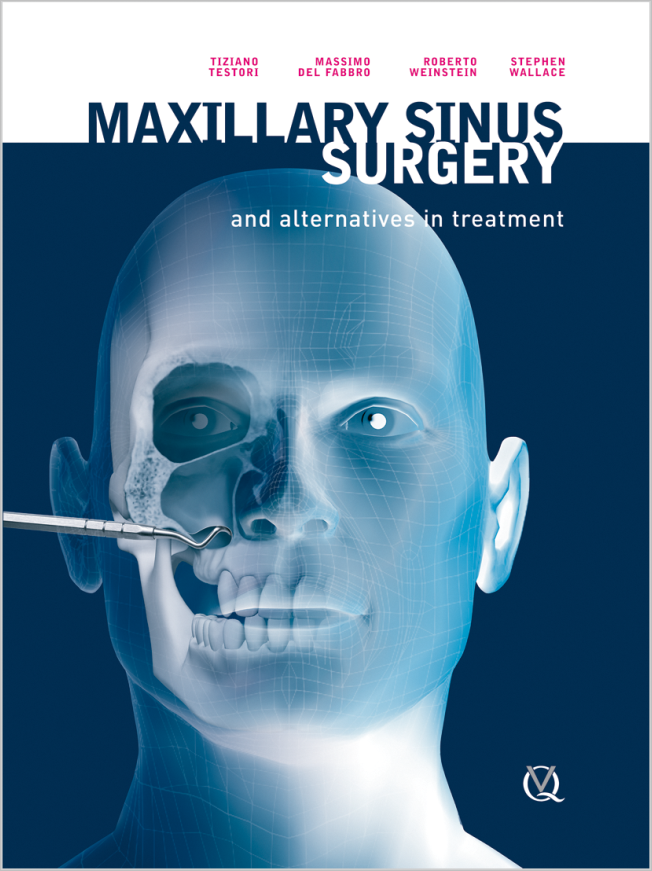International Journal of Periodontics & Restorative Dentistry, 6/2018
DOI: 10.11607/prd.3036, PubMed-ID: 29451926Seiten: 819-825, Sprache: EnglischFrancetti, Luca / Weinstein, Roberto / Taschieri, Silvio / Corbella, StefanoGingival recession can cause an esthetic impairment or dentin hypersensitivity due to root surface exposure to the oral cavity. These conditions may require specific surgical interventions to achieve root coverage. This controlled clinical trial on 20 subjects compared coronally advanced flap (CAF) technique and CAF plus subepithelial connective tissue graft (CTG) for the treatment of single maxillary gingival recession. Recession height (REC) and complete root coverage (CRC) were considered as primary outcomes. The residual REC was 2.90 ± 0.99 mm at baseline, 1.10 ± 0.99 mm after 1 year, and 1.15 ± 1.06 mm after 5 years in the CAF group and 2.70 ± 0.48 mm at baseline, 0.55 ± 0.69 mm after 1 year, and 0.44 ± 0.62 mm after 5 years in the CAF + CTG group. The differences between groups at 5 years of follow-up was statistically significant. CRC was obtained in 60% of teeth in the CAF group and in 70% of teeth in the CAF + CTG group at the 5-year followup. The results showed a significant difference between CAF and CAF + CTG techniques for the treatment of single recession with regard to REC; no significant difference was found in the percentage of teeth presenting CRC after 5 years.
International Journal of Periodontics & Restorative Dentistry, 2/2018
DOI: 10.11607/prd.3480, PubMed-ID: 29447323Seiten: 281-288, Sprache: EnglischDel Fabbro, Massimo / Nevins, Myron / Venturoli, Daniele / Weinstein, Roberto L. / Testori, TizianoThe aim of the present survey was to define the most appropriate recall regimen and professional maintenance care protocol, identifying the main relative issues, based on a consensus of experts with long-term clinical experience. The survey consisted of 14 clinically relevant focused questions. The answers of each expert were aggregated to formulate clinical recommendations. The maintenance care protocol must be individually determined and a baseline condition identified. The recall frequency must have a specific periodicity, and bone levels must be radiographically checked at least every 2 years, unless specific needs require a shorter interval.
The International Journal of Oral & Maxillofacial Implants, 5/2017
DOI: 10.11607/jomi.5263, PubMed-ID: 28231347Seiten: 1001-1017, Sprache: EnglischCorbella, Stefano / Taschieri, Silvio / Francetti, Luca / Weinstein, Roberto / Del Fabbro, MassimoPurpose: The aim of this systematic review was to investigate which material is the most effective bone substitute for alveolar bone healing by evaluating histomorphometric outcomes after healing of postextraction sockets in humans.
Materials and Methods: A manual and electronic search (PubMed, EMBASE, Cochrane Library) was performed using a search string prepared ad hoc. Data were statistically analyzed by calculating weighted mean percentage of new bone formation (primary outcome) and weighted mean percentage of residual biomaterial, soft/connective tissue, and nonmineralized tissue (secondary outcomes) in the biopsies. A meta-analysis of the included randomized controlled trials (RCTs) was performed.
Results: A total of 802 papers were screened. After application of the inclusion and exclusion criteria, a total of 40 articles were included in the quantitative synthesis while 11 were included in the meta-analysis of comparative studies. The evaluation of comparative studies with empty sites as control showed that bovine bone could lead to a lower proportion of new bone formation compared to sites left to heal spontaneously (P .00001). Magnesium-enriched hydroxyapatite and porcine bone showed a significantly higher percentage of new bone compared to control sites (P .00001). Grafting with an allograft did not lead to a higher percentage of new bone formation in comparison with control sites (P = .09).
Conclusion: There was no evidence for the superiority of a given biomaterial over the others in terms of new bone formation. While calcium sulphate and beta-tricalcium phosphate resorbed faster than other biomaterials, xenografts showed a lower resorption rate than allografts. Comparative studies suggested that bovine bone was related to a lower proportion of new bone volume compared to sites left to heal spontaneously, while porcine bone and magnesium-enriched hydroxyapatite were related to higher new bone volume. Allograft was not related to higher new bone volume than sites healed without any biomaterial.
Quintessence International, 3/2016
DOI: 10.3290/j.qi.a34980, PubMed-ID: 26504910Seiten: 193-204, Sprache: EnglischCorbella, Stefano / Taschieri, Silvio / Del Fabbro, Massimo / Francetti, Luca / Weinstein, Roberto / Ferrazzi, EnricoObjective: The correlation between periodontal status and systemic conditions, among them pregnancy, is widely described in the scientific literature. The aim of the present systematic review of the literature was to evaluate periodontal diseases as an independent risk factor for adverse pregnancy outcomes.
Data: Case-control studies reporting pregnancy outcomes and periodontal status of the subjects were included. Risk of bias evaluation was performed using a tool developed by the Cochrane Bias Methods Group. After risk of bias evaluation of included studies, a meta-analysis was performed computing the Risk Ratio (RR) for each pregnancy outcome.
Sources: Electronic databases (MedLine, Embase, Cochrane Central) were searched after preparation of an appropriate search string.
Study selection: The search resulted in 422 entries that were screened. After application of inclusion and exclusion criteria, a total of 22 studies were included in the review accounting for a total of 17,053 subjects. The computed RR for periodontitis was 1.61 for preterm birth evaluated in 16 studies (P .001), 1.65 for low birthweight evaluated in 10 studies (P .001), and 3.44 for preterm low birthweight evaluated in four studies.
Conclusion: The present systematic review reported a low but existing association between periodontitis and adverse pregnancy outcomes. This assumption is the result of proper corrections of biased methodologies and of heterogeneity of studies. (
Schlagwörter: adverse pregnancy outcomes, meta-analysis, periodontal diseases, periodontitis, risk factor
International Journal of Oral Implantology, 4/2014
PubMed-ID: 25422822Seiten: 333-344, Sprache: EnglischDel Fabbro, Massimo / Corbella, Stefano / Taschieri, Silvio / Francetti, Luca / Weinstein, RobertoBackground: Autologous platelet concentrates are claimed to enhance hard and soft tissue healing due to the considerable amount of growth factors that are released after application in the surgical site. However, their actual efficacy for improving tissue healing and regeneration in oral surgery applications is controversial. Tooth extraction socket healing represents a proper model to study the effect of autologous platelet-enriched preparations due to the concomitant occurrence of different processes of both hard and soft tissue healing.
Purpose: To evaluate the efficacy of platelet concentrates for alveolar socket healing after tooth extraction, by conducting a systematic review.
Materials and methods: Medline, Embase and Cochrane Central Register of Controlled Trials were searched using a combination of specific search terms. The last electronic search was performed on 15 June, 2014. Manual searching of the relevant journals and of the reference lists of reviews and all identified randomised controlled trials was also performed. Randomised controlled trials evaluating the effect of a platelet concentrate on fresh extraction sockets were included. Further inclusion criteria were that at least 10 patients were treated (at least 5 per group) and there was a minimum follow-up duration of 3 months. Primary outcomes were postoperative complications, patient satisfaction and postoperative discomfort. Secondary outcomes were any clinical, radiographic, histological and histomorphometric variables used to assess hard and soft tissue healing. Assessment of the methodological quality of the trials was made. Results were expressed as fixed-effects models using mean differences for continuous outcomes and risk ratios for dichotomous outcomes, with 95% confidence intervals (CI).
Results: The initial search yielded 476 articles. After the screening process, six articles met the inclusion criteria (199 teeth in 156 patients). Three studies were considered at high risk of bias, two at medium risk and one at low risk. A large heterogeneity in study characteristics and outcome variables used to assess hard tissue healing was observed. A meta-analyses of two studies reporting histomorphometric evaluation of bone biopsies at 3 months' follow-up showed greater bone formation when platelet concentrates were used, as compared to control cases (P 0.001; mean difference 20.41%, 95% C.I. 13.29%, 27.52%). Beneficial effects of platelet concentrates were generally but not systematically reported in most studies, in particular when considering the effects on soft tissue healing and the patient's reported postoperative symptoms like pain and swelling, although no meta-analysis could be done for such parameters.
Conclusions: Although the results of the meta-analysis of the present review are suggestive for a positive effect of platelet concentrates on bone formation in post-extraction sockets, due to the limited amount and quality of the available evidence, they need to be cautiously interpreted. A standardisation of the experimental design is necessary for a better understanding of the true effects of the use of platelet concentrates for enhancing post-extraction socket healing.
Schlagwörter: platelet concentrates, socket healing, systematic review, tooth sockete
Conflict of interest statement: The authors declare they have no conflicts of interest.
The International Journal of Oral & Maxillofacial Implants, 5/2012
PubMed-ID: 23057031Seiten: 1170-1176, Sprache: EnglischTestori, Tiziano / Weinstein, Roberto L. / Taschieri, Silvio / Fabbro, Massimo DelPurpose: Implant-supported rehabilitation of the atrophic posterior maxilla often necessitates maxillary sinus surgery to augment existing bone volumes. Recent systematic reviews have reported implant survival rates above 90% following sinus elevation. However, statistical assessment of the effect of anatomic factors, implant design and surface, individual risk factors, and complications related to sinus floor elevation procedures on implant survival through analyzing patient data has not yet been performed. The aim of this study is to identify risk factors that might affect implant survival following sinus elevation.
Materials and Methods: Three centers were involved in this retrospective multicenter study; 106 patients were treated with 144 sinus elevation procedures and received 328 implants. The mean follow-up was 48.4 months, and the longest follow-up period was 72 months. The analysis considered patient age, gender, health status, and smoking habit; implant size, shape, and surface; residual ridge height; timing of implant placement with respect to grafting; graft material; and the occurrence of surgical complications. For quantitative variables, the Pearson correlation was used. The chi-square test and Fisher exact test (for samples smaller than five units) were used for qualitative variables.
Results: The cumulative implant survival rate was 93.0% up to 5 years. Complications occurred in 41 patients. Intraoperative sinus membrane perforation occurred in 40 sinuses (28%) and was not a significant risk factor for implant survival. Six patients experienced postoperative infection leading to graft failure, and two patients had considerable intraoperative bleeding. Smoking more than 15 cigarettes/day and a residual ridge height 4 mm were significantly associated with reduced implant survival.
Conclusions: Smoking habits and residual ridge height should be evaluated carefully prior to sinus elevation procedures.
Schlagwörter: atrophic maxilla, maxillary sinus elevation, residual ridge, sinus membrane perforation, smoking
International Journal of Periodontics & Restorative Dentistry, 3/2012
PubMed-ID: 22408774Seiten: 295-301, Sprache: EnglischTestori, Tiziano / Iezzi, Giovanna / Manzon, Licia / Fratto, Giovanni / Piattelli, Adriano / Weinstein, Roberto L.Among the graft materials that can be used clinically, xenografts are the most common. Xenografts are of bovine, porcine, or equine origin and require the complete removal of proteins to avoid immunologic problems and the risk of transmission of prions, viruses, etc. Protein destruction can be achieved by a chemical procedure using organic solvents and heat treatment. After this process, a carbonated hydroxyapatite similar to human bone remains. The aim of this case report is to investigate the bone formation in a sinus augmentation procedure using a high temperature-treated bovine porous hydroxyapatite. A 58-year-old woman underwent bilateral sinus augmentation using this biomaterial. After 9 months, during stage-two surgery, two core biopsy specimens were retrieved and treated to obtain thin ground undecalcified sections. Microscopically, newly formed bone was present at the interface with most particles. The major portion of the particles appeared to be completely lined and surrounded by bone. No obvious signs of resorption were present on the biomaterial surface. No gaps or connective tissue were present at the bone-biomaterial interface. No inflammatory infiltrate or fibrous encapsulation of the particles was present. Histomorphometry showed that the percentages of newly formed bone, residual grafted particles, and marrow spaces were 25.1% ± 2.3%, 37.3% ± 1.1%, and 38.5% ± 3.1%, respectively. The excellent properties demonstrated by Endobon are probably a result of its particular hydroxyapatite porous microstructure with a high percentage of interconnected micropores that promote the ingrowth of osteogenic cells and vessels, making graft integration easier and faster.
International Journal of Periodontics & Restorative Dentistry, 3/2008
PubMed-ID: 18605602Seiten: 265-271, Sprache: EnglischTaschieri, Silvio / Del Fabbro, Massimo / Testori, Tiziano / Saita, Massimo / Weinstein, RobertoThe purpose of this prospective study was to assess the outcome of periradicular surgery with or without guided tissue regeneration (GTR) for the treatment of through-and-through lesions. Thirty-four teeth were included according to specific selection criteria. In the test group (using GTR), after root-end filling, the defects were filled with anorganic bovine bone and covered with a resorbable collagen membrane. Healing was assessed according to specific criteria and graded as successful, doubtful, or failed. In the control group, neither grafts nor membranes were used. After 1 year, 31 teeth were evaluated. Of these, 22 (71%) healed successfully, 6 (19%) showed doubtful healing, and 2 were recorded as failures. The outcomes of the defects treated with GTR (88% successful) were significantly better than those of the control group (57% successful). The present study showed that the use of GTR associated with anorganic bovine bone in the treatment of through-and-through lesions may positively affect the healing process.
International Journal of Periodontics & Restorative Dentistry, 1/2008
PubMed-ID: 18351198Seiten: 9-17, Sprache: EnglischTestori, Tiziano / Wallace, Stephen S. / Del Fabbro, Massimo / Taschieri, Silvio / Trisi, Paolo / Capelli, Matteo / Weinstein, Roberto L.The most frequent intraoperative complication with sinus elevation is perforation of the schneiderian membrane. In most instances, the repair of this perforation is necessary to contain particulate grafting material and complete the procedure. New techniques are presented here for the management of large perforations of the schneiderian membrane. A bioabsorbable collagen membrane is stabilized outside the antrostomy and then folded inward to create either a new superior wall that can obliterate a large perforation or a "pouch" that can completely contain the particulate material. This can make it possible to complete a procedure that otherwise may have had to be aborted by preventing dispersion of the particulate graft within the sinus cavity. Clinical cases are shown, along with follow-up at 6 to 9 months, demonstrating histologic and/or radiographic evidence of success, continued sinus health, and superior vital bone formation. The authors have used this technique on 20 consecutive patients without experiencing any procedural failures.
International Journal of Periodontics & Restorative Dentistry, 3/2006
PubMed-ID: 16836167Seiten: 248-263, Sprache: EnglischDel Fabbro, Massimo/Testori, Tiziano/Francetti, Luca/Taschieri, Silvio/Weinstein, RobertoThe primary goal of this paper was to determine the survival rate of immediately loaded (IL) dental implants based on a systematic review of the literature. Secondary goals were to determine the influence of several factors on the implant survival rate, such as the type of reconstruction, implant location, and implant surface characteristics. An electronic search of databases was performed, in addition to a hand search of the most relevant journals. All relevant articles were independently screened according to specific inclusion criteria. The selected papers were reviewed. The literature search yielded 270 applicable articles up to December 2005. Of these, 71 met the inclusion criteria for qualitative data analysis. Eight articles were randomized controlled trials. The overall implant survival rate for the included studies was 96.39%. The database included 10,491 IL implants placed in 2,977 patients, with a maximum follow-up of 13 years. IL is well documented and predictable for the edentulous mandible (overdentures and full-arch prostheses) and for maxillary single crowns. Fewer data were found for maxillary full-arch reconstructions, fixed partial prostheses, and mandibular single crowns. For the latter two types of reconstructions, implants placed in anterior sites generally displayed a higher survival rate versus those placed in posterior sites. Rough surfaces displayed a higher survival rate than machined surfaces in all types of reconstructions. Most failures (97.1%) occurred within the first 12 months of loading. This review showed that it is possible to apply IL with excellent survival rates. Implant micromorphology and careful patient selection may affect treatment outcomes.






